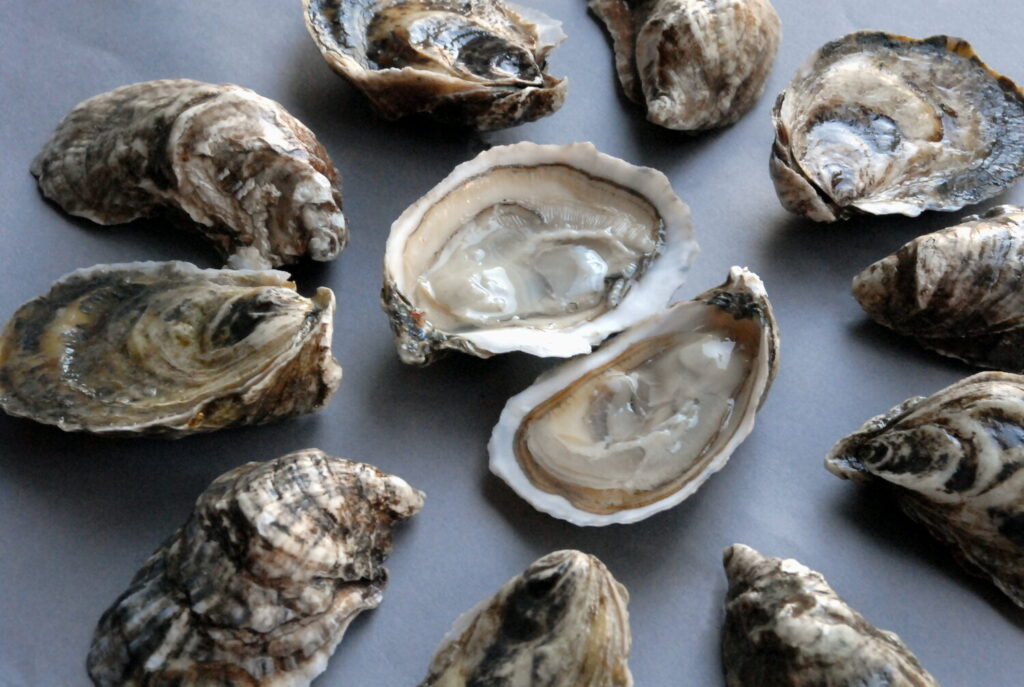OSTRA (P)
OYSTER (E)
huître (F)
ostrica (I)
oSTRA (S)
wellfleet, cape cod, massachusetts
Okay, just to be clear, choosing Wellfleet as our Place doesn’t mean Wellfleet oysters are the best. Some might argue they are but there are other worthy candidates from all over the world. The Wellfleet oyster is described as having a briny sweetness with a touch of seaweed. And beauty (or in this case, a great tasting oyster) is in the eye of the beholder. Even an avid oyster lover can come across an oyster whose flavor or consistency they don’t love.

Luckily, there is a lot of variety in the oyster world. In North America alone, there are five different species of edible oyster: 1) Eastern (crassostrea virginica); 2) Pacific (crassostrea gigas); 3) Kumamoto (crassostrea sikamea); 4) European Flat (ostrea edulis); and Olympia (ostrea conchiphila/lurida). And oysters are grown all over the world. Some of the more famous are: Bluff oysters from the southern-most tip of New Zealand’s South Island; Speciales Gillardeau, produced by the Gillardeau family near La Rochelle in western France; Sydney Rock oysters, grown all over Australia; Kelly Oysters from Galway, Ireland; Loch Ryan oysters from Scotland; and Belon Oysters from Finistère, France.
Oysters filter water in order to eat so what’s in the water can really affect the taste of an oyster. In oysterspeak, the factors that influence an oyster’s taste is known as “merroir”, a variation of the French word terroir which refers to the environment in which grapes are grown, specifically, the soil; the vine stock; and the planting habits of a vineyard. The merroir of an oyster might include the saltiness of the water; the minerals in the sediment; the type of algae in the water the oyster is filtering; and how the oyster is grown.
Oysters are either grown in farms or in the wild. Both farmed and wild oysters are grown in the same environment and they both filter the same water. But farmed oyster are cared for by growers and they do need a bit of care. Did you know that oysters have a lot of predators: the boring sponge; the oyster drill, whelk; crabs; lobsters; starfish; oyster flatworms and leeches; parasites; and even fish. Oyster growers use gear and certain techniques to assist their oysters. For example, the Truro Pearl oyster (Truro being the next town over from Wellfleet) are grown in floating bags in the spring and summer. In the fall, they are brought in, put in bottom cages and sunk in deep water for the winter.
By contrast, wild oysters grow in particular places, known as beds, and are caught by shell fishermen, often using dredges. Of the two types, farmed oysters are more sustainable. Wellfleet harbor has both types. Wild Wellfleet oysters, found attached to rocks and shells, are picked at low tide by fishermen. Farmed Wellfleet oysters are literally planted. Oyster seed is put in fine mesh bags on racks in the water and then moved to bigger bags as the oysters grow.
From the 1830s to the 1870s, Wellfleet was the oyster capital of New England. According to historians, there were forty schooners hauling seed oysters to Wellfleet and hauling mature oysters to Boston and New York. Canned oysters were popular with Union Army soldiers during the American Civil war and by 1848, Boston had 69 oyster houses. People even went around Boston selling oysters door-to-door. But the true oyster capital of America was New York City. New York harbor had 350 square miles of oyster beds and, it was estimated, contained half the world’s oysters. New York was famous for its oyster cellars and everyone in New York, rich or poor, ate oysters.
Sadly, the oyster’s need to filter up to 50 gallons of water daily in order to survive was the downfall of the New York oyster. By 1927, the last of New York’s oyster beds had been closed due to toxicity caused by industrial waste and sewage. Oysters are now growing again in New York harbor and are part of the process of cleaning the waters. They are also forming oyster reefs which provide neighborhoods for other marine species and prevent storm surge. But sadly, even today, more than 50 years after the provisions of the Clean Water Act of 1972 started improving the waters of the United States, it is not safe to eat a New York oyster. They are too toxic to eat due to the heavy metals, PCB’s and other chemicals still in the sediment of the harbor.
Let’s end on a happier, or rather, tastier note. Some oyster aficionados argue the best way to eat an oyster is raw and naked, or, just maybe, with a little lemon, cocktail sauce or mignonette sauce (made with vinegar and shallot). But there is so much more you can do with an oyster. Head from Truro to Provincetown, at the very tip of Cape Cod, and check out the Provincetown Seafood Cookbook by the late Howard Mitchum. A great chef, writer and Renaissance man whose 1975 book (reissued in 2018 with an introduction by the late Anthony Bourdain who got his start in Provincetown) contains scrumptious recipes for Oysters Rockefeller and Bienville; the Oyster Po’Boy sandwich (from New Orleans, Louisiana, another oyster town); and Oyster stew, among others. As another great chef, Julia Child, was fond of saying, Bon appétit!